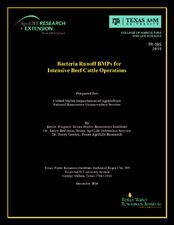| dc.description.abstract | According to the 2008 Water Quality Inventory and 303(d) List, 291 of the 516 impairments (i.e. 56%)
were the result of excessive bacteria. Modeling and bacteria source tracking has identified grazing cattle
as a source of this bacterial contamination. To help address this, the Natural Resources Conservation
Service (NRCS) funded this project to evaluate the effect of stocking rate on pathogen transport from
beef cattle operations and develop guidance for landowners on restoring water quality.
The project included three tasks: (1) Project Coordination and Administration, (2) Assess Bacteria Runoff
from Intensively Managed Beef Cattle Operations, and (3) Technical Transfer. Task 1, Project
Coordination and Administration, consisted of the Texas Water Resources Institute (TWRI) preparing
and submitting eleven quarterly progress reports and the final project report, holding 25 coordination
meetings, and submitting 12 invoices.
To evaluate the impact of grazing management on bacterial runoff (Task 2), TWRI and Texas AgriLife
Extension Service (AgriLife Extension) installed three 1-hectare watershed sites at the Texas A&M
University Beef Cattle Systems Center (BCSC), located near College Station. Sites were bermed and
equipped with 90o v-notch weirs, ISCO® samplers with bubble flow meters, and a rain gage. TWRI and
AgriLife Extension maintained these watershed sites for two years, conducting over 30 site visits.
A variety of stocking rates were evaluated. Site BB1 was ungrazed. Site BB2 was stocked at typical
stocking rates (SR) for the area (i.e., 3-4 acres per animal unit [AU]). Site BB3 was stocked at a rate twice
that of site BB2. Over the course of the project, six grazing treatments were conducted at sites BB2 and
BB3.
From November 2008 through October 2010, TWRI and AgriLife Extension assessed bacterial
concentrations and runoff volume from the watershed sites. E. coli concentrations at all sites greatly
exceeded Texas Water Quality Standards. Even at the ungrazed site, non-domesticated animals (i.e.,
feral hogs) and wildlife significantly impacted E. coli levels preventing attainment of water quality
standards, thus indicating the difficulty in achieving standards during runoff events due to background
loadings. Data also indicated moderate stocking does not significantly increase E. coli levels above
background levels and suggests that 67-85% reductions in E. coli levels may be achieved by converting
from heavy to moderate stocking rates. It was also found that pastures stocked heavier than 10 acres
per AU should be the primary focus of implementation efforts in this and similar environments. Our data
indicated (1) stocking at rates heavier than 10 acres per AU (as is much of the improved pastureland in
Texas) may increase E. coli concentrations in runoff while (2) stocking at rates less than 10 acres per AU
(much of the rangeland in Texas) does not yield higher E. coli levels than ungrazed pastures. Finally, data
show that runoff events occurring while the sites were stocked or within two weeks of them being
stocked produced the highest E. coli concentrations; thus, it is recommended grazing in creek pastures
be deferred during rainy periods. Within two weeks of grazing, E. coli levels had fallen substantially and
after 30 days, E. coli values had declined to background levels. The findings and recommendations regarding appropriate stocking rates/grazing management to
minimize bacterial runoff into surface waters of Texas are being included in a fact sheet, presentation,
and other resources that will become part of the Lone Star Healthy Streams Beef Cattle Resource
Manual.
Throughout this project a series of educational programs conducted through the Lone Star Healthy
Streams Program transferred information regarding bacterial runoff and conservation practices for
reducing it to livestock producers at over 60 programs around the state. Additionally, the website
reached 1,038 unique visitors since its inception. These programs have increased awareness of bacterial
runoff from beef cattle grazing operations and conservation practices designed to reduce bacterial
loading to Texas streams and water ways.
Much work remains to be done. The applicability of water quality standards during runoff events should
be evaluated in light of the findings of this study; more data is needed to evaluate the impact of stocked
pastures on bacterial runoff; work is needed to assess the impacts of continuous grazing on E. coli
runoff; and transfer of this information to cattlemen throughout Texas must continue. | en |


